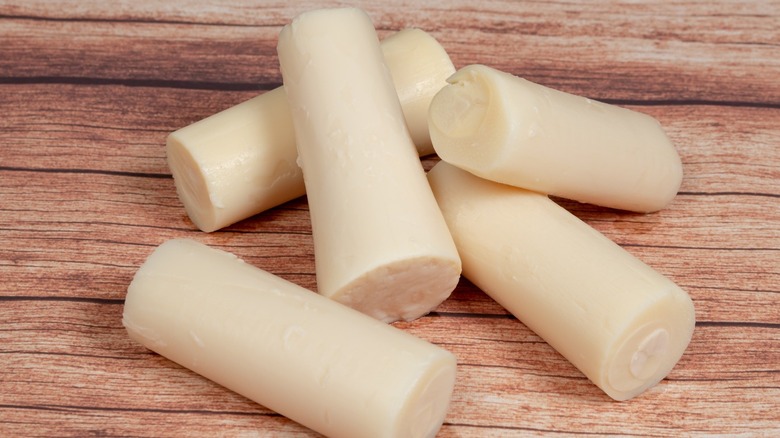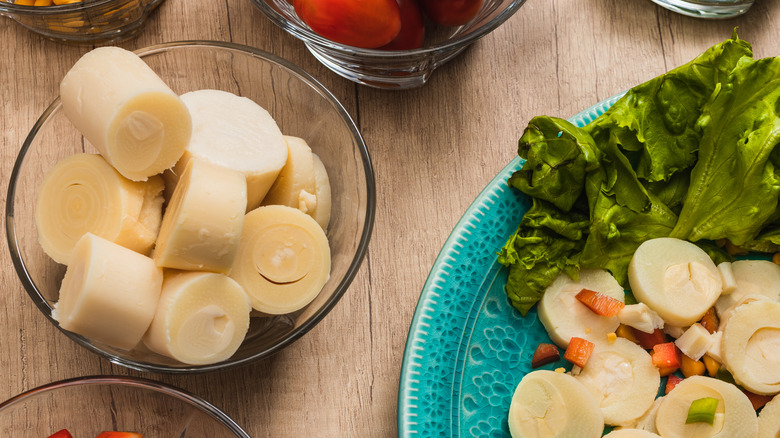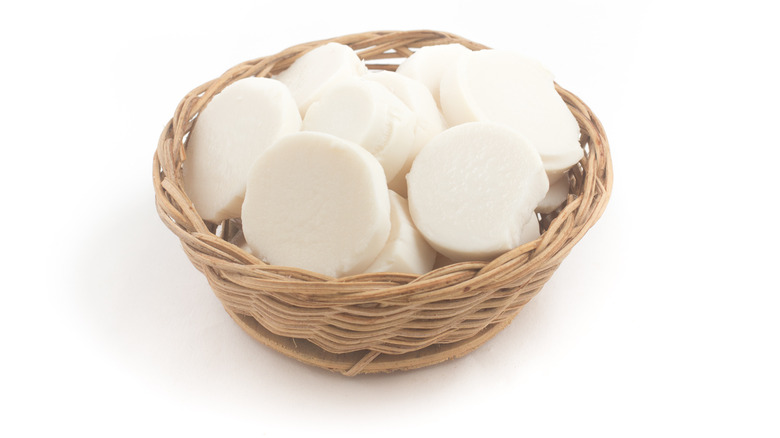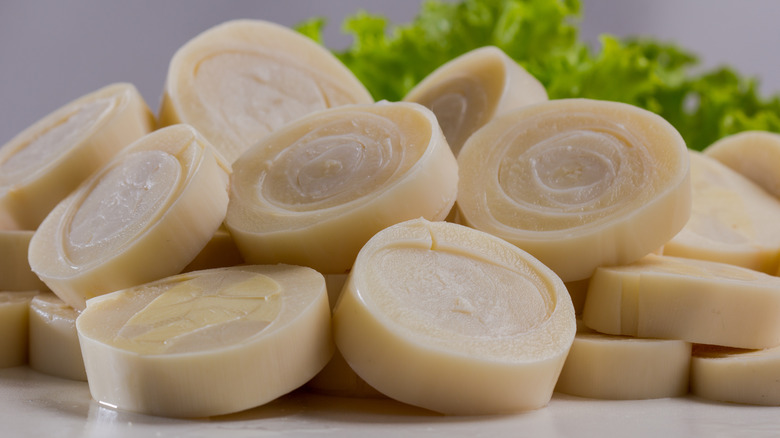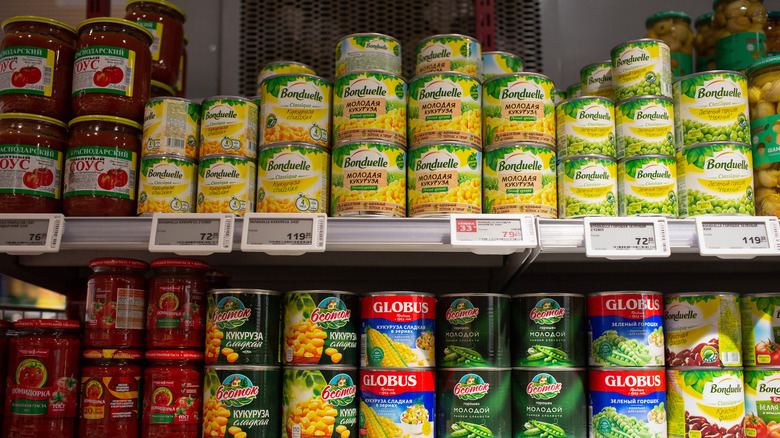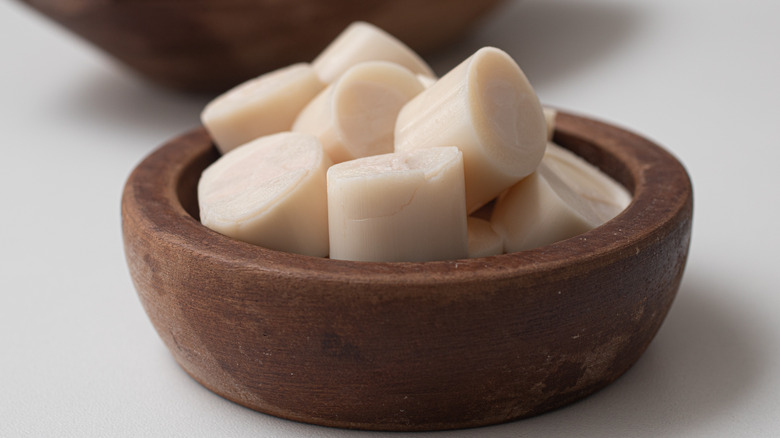What Are Hearts Of Palm And What Do They Taste Like?
The vegetable world is full of unique options. Case in point? Hearts of palm. This veggie comes from the insides of palm trees and adds a crunchy texture to a variety of dishes, including salads and dips. Their flavor is mild, and they're delicious raw, grilled, sautéed, and more.
In addition to the appeal of their unconventional taste and texture, hearts of palm a solid nutritional profile, too. They're relatively low in fat and calories and provide a number of essential nutrients, as well as antioxidants, per Healthline.
Hearts of palm aren't hard to find, either — your local grocery store probably has a canned version of this veggie in stock. (According to Food52, buying fresh hearts of palm is "not worth the hassle," and the canned version tastes just as good.) Even if you've never heard of this veggie before, it's well worth experimenting with in your next recipe.
What are hearts of palm, and how are they made?
As Food Network explains, hearts of palm are vegetables that come from the core of palm trees, which are commonly found in Central and South America, as well as in U.S. states such as Florida. If you see a menu list items that include palmito, chonta, or palm cabbage, they're referring to hearts of palm, Food Network notes.
While the bark and leaves of palm trees aren't edible, the nutrient-packed hearts of palm are made from the debarked tree cores, Healthline explains. And as Food Network notes, hearts of palm are a sustainable crop, which is great news if you're trying to eat in an environmentally-friendly way.
According to The Spruce Eats, after they're harvested, hearts of palm are cut into their signature tube shape or sliced into circles and placed in water or brine to prolong their shelf life.
What do hearts of palm taste like?
When you look at hearts of palm, you may be reminded of asparagus. But taste-wise, they're in a league of their own. As per The Spruce Eats, the taste of hearts of palm can be best described as "delicate." Their mild flavor isn't overpowering, making them the perfect addition to recipes where you want to let the other ingredients shine.
According to Food52, hearts of palm are often seen as a cross between asparagus, artichoke hearts, and water chestnuts. They can even act as a substitute for meat or seafood if you're after a similar texture.
Food Network compares the taste and texture of raw hearts of palm to jicama, thanks to their "crunchy and sweet" nature. If eating them raw doesn't appeal to you, you can blend them into a creamy vegetable dip or toss them on the grill alongside other vegetables.
How to cook with hearts of palm
Hearts of palm are versatile and delicious. Need a creamy dip? You should incorporate hearts of palm, suggests Food & Wine. All you need is a bit of olive oil, garlic, and lime zest (along with hearts of palm) to make a dip that's both healthy and yummy.
They're a great salad topping, too, pairing well with watercress and avocado, per Food & Wine. If you're feeling ambitious, you can make hearts of palm into pasta, as Food Network suggests.
You can even eat hearts of palm on their own. One Redditor writes, "I just eat them straight up, after drying them off a bit. So yummy, and such an interesting texture!" Meanwhile, another commenter mentioned that they love adding hearts of palm to homemade pizza. Want something unconventional? Another Redditor suggested adding them to crab cakes for an unexpected burst of flavor.
Where to buy hearts of palm
Plenty of supermarkets stock jars and cans of hearts of palm. They're fairly affordable, with price points similar to those of other canned vegetables; a 14-ounce jar of hearts of palm from Walmart's Great Value label costs $2.36. Brands including Delallo, Goya, and Sprouts also make hearts of palm, so there's a good chance at least one variety will be in stock at your local grocery store.
However, if you'd rather buy fresh hearts of palm, you'll likely have to turn to specialty grocery stores. Just know that fresh hearts of palm can't be stored for too long; per VeryWellFit, they'll stay fresh for two weeks at most.
Fresh hearts of palm will also set you back a significant amount of money when compared with their canned counterparts. One pound of fresh, trimmed hearts of palm costs a whopping $32.90 from Fresh & Wild.
Nutritional information about hearts of palm
According to VeryWellFit, hearts of palm are fairly low in calories. Around 73 grams of the vegetable contains around 20 calories and provide 0.5 grams of fat, 3.4 grams of carbs, and 1.8 grams of protein.
Hearts of palm also boast several essential nutrients, including vitamins B6 and B2, copper, iron, potassium, zinc, and phosphorus. They're also high in fiber and are believed to be good for those who want to control their blood pressure and cholesterol levels. Additionally, they're high in iron and vitamin C and can help prevent deficiencies in those minerals.
Hearts of palm also a solid tool for weight management, as they can help you stay full for longer periods. The only downside worth noting is that cans and jars from the supermarket may contain added sodium, so it's a good idea to rinse canned hearts of palm with water.
